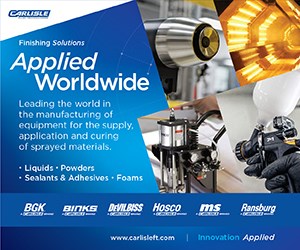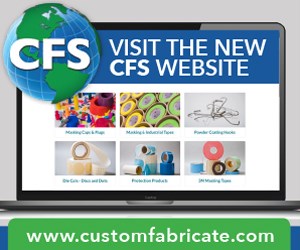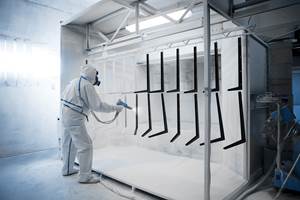Evaluating and Solving Racking Needs on Any Scale
Taking on a new coating project can be challenging, but Donovan Dixon of ProductionPlus says proper planning can make things go smoother, especially if you are implementing a new line or a larger project.
Q: I have a large-scale project looming and I am looking at a comprehensive racking system that can lower my costs and increase density. What advice do you have for planning this project?
A: Taking on a new project can be challenging. There are seemingly endless details to take into consideration, especially if you are installing a new line. Some questions you will be asking yourself are: What size paint booth do I need and how many guns? Do I need a large curing oven? What is my line speed going to be? Racking is often one of the last details that are considered. However, nothing has more impact on overall system performance than racking design.
There is a step-by-step process that most suppliers use to make sure they are optimizing their capabilities, no matter the project. First, answer the following detailed questions about your system and parts. The proper rack design will accommodate both and maximize your finishing process.
Survey Your System:
- What is your application—powder, liquid, ecoat or conversion coating? This answer will determine how much part control is needed and what type of rack adjustability can be used to re-establish electrical ground, if required.
- What type of conveyor do you use—P and F, monorail, hoist or batch?
- Can you paint parts from both sides or must the rack swivel?
- Are there inclines and declines on the conveyor? What is the maximum degree? This will affect the center of gravity on the rack, if hanging from two points. The maximum degree will also be used to calculate maximum rack width.
- What is the conveyor pendant style — H attachment or swivel casting? Is it centered on 6, 8 or 24 inches? What is the maximum weight per pendant? Are there load bars?
- Will the racks be burned off or exposed to an acid to be cleaned? (Stainless hooks and racking may be required versus high-carbon steel.)
- What are the smallest dimensions of the booth, oven, washer or tanks?
- How fast does the line travel? Can racks or heavy parts be loaded at that speed?
- Are load bars required to carry the parts around the line, relieving conveyor stress or distribute weight across pendants?
- How will racks be moved to and from the line area? How will they be loaded onto the conveyor and removed? The rack must be easy on and easy off.
Once a supplier has familiarized themselves with your system, the next step is rack design. AutoCAD files and/or samples of the part being racked are often required to start the design process. Generally, a quote is put together for the design phase (which includes prototyping) of the project. Then, once accepted, 3D drawings are created, showing your part hanging on their rack going through your system. These solutions are reviewed and tweaked until a final prototype build is agreed on.
Combined with the samples and/or CAD files, suppliers will also look at other criteria regarding your part:
- What is your coating — powder, liquid or ecoat?
- Are you painting both sides of the part?
- Is masking required?
- Will the part be washed? Will it drain naturally?
- Are there preferred holes for hanging this part?
- Is the part light enough to blow off of a standard hook in the washer?
- What is the most important coverage area?
- Will a custom hook be needed?
- Is a dedicated rack needed for this part or will an adjustable rack with interchangeable crossbars work?
- Will the hooks need to be changed out of the rack to accommodate other parts? If so, can you change the hooks at any time?
- Can the part be stabilized on the rack versus hanging freely?
- Are any blemishes allowed?
- What is the desired hanging position — side or front?
- What is the weight of the part?
With these criteria in mind, here are other ways to save money through the design process:
- Add more parts to the same space. Maximizing part density is the No. 1 money-saving criteria in rack design. Ease-of-rack use is paramount when high density is implemented.
- Eliminate the labor cost of “daisy-chaining” hooks. This costs 50 percent or more in labor versus racking because the hooks must be hung before hanging the actual parts. Profitable finishing lines use racks instead of individual hooks, which allows lines to run at maximum speeds, sometimes as much as 70 feet per minute.
- Look at offline loading and unloading. Often, racks can be loaded and unloaded offline, again allowing lines to run at maximum speed while fully loaded racks are moved to and from the line. Sadly, most lines run slower than designed, hindered by how fast people can hang parts directly on the line.
- Reduce hourly overhead line costs. Racking increases the number of parts finished per foot per hour, reducing the cost per part associated with the hourly overhead of the finishing line. This includes costs such as chemicals, utilities, maintenance, labor, paint, cleaning, waste disposal and more.
When analyzing racking potential, it is best to stage and load racks at the workstation, if possible, to eliminate rehandling of parts. Seriously consider offline loading and unloading of racks. Carts can be used to transport the racks to and from the line, burn-off facilities and more.
Fully taking advantage of today’s technologies, including using 3D software, allows seamless communication between the design team and project managers. Thinking about racking needs as one of the first steps in your project will help ensure you have the time and resources to achieve a successful and profitable end result.
Donovan Dixon is with Production Plus Corp.
Related Content
A Software Platform for Self-Programming, Autonomous Robotics
Omnirobotic is delivering an automation solution that could transform the way finishing shops consider robotics.
Read MoreThe Real Cost: C-Hooks Versus Parts Racks
Industrial finishing line consultant Dan Davitz discusses the advantages of parts rack over the use of C-hooks for your paint or powder coating line.
Read MoreHTE Powder Coatings Take Coverage to the Next Level
High-transfer efficient powder coatings deliver cost, time and energy savings.
Read MoreFilm Thickness Control
Have a powder coating job that requires precise film thickness control? Products Finishing columnist Rodger Talbert offers advice controlling the variables that can impact your success.
Read MoreRead Next
The 2024 Ford Mustang: All the Colors Available
Although Chevrolet has announced the end of the Camaro and Dodge is offering “Last Call” editions of the Charger and Challenger, the Ford Mustang is launching to its seventh generation.
Read MorePowder Coating 4.0: Smarter, Faster, More Efficient and Connected
New tools reduce cost and waste, lower manufacturing footprint of powder coating operations.
Read MoreEpisode 42: An Interview with Robin Deal, Hubbard-Hall
Hubbard-Hall wastewater treatment specialist Robin Deal discusses the latest trends in wastewater management.
Read More

























